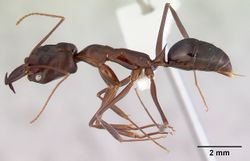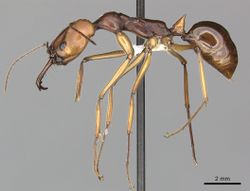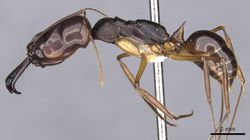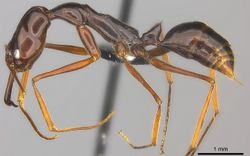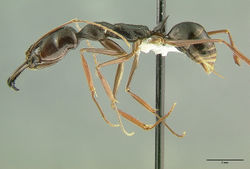Key to Odonotomachus of the Indo-Australian Region
This worker key is based on: Brown, W. L., Jr. 1976c. Contributions toward a reclassification of the Formicidae. Part VI. Ponerinae, tribe Ponerini, subtribe Odontomachiti. Section A. Introduction, subtribal characters. Genus Odontomachus. Stud. Entomol. 19:67-171.
This is an older key but will work well for many Odontomachus species.
Brown noted the following regarding this key:
Before trying the keys, the user should be aware of the special conditions of measurement of this genus, especially for HL and HW (Headlength is measured full-face in the usual way, except that the anterior limit of the head is normally taken as the rounded anterior swellings of the mandibular condyles, which, though not strictly a part of the head proper, nevertheless do complete the outline of the head in front when one or both mandibles are closed (see Figure 2). Headwidth in ants is usually taken across the widest part of the head; in the present genera, the head is widest in the anterior quarter or third, across the eyes and ocular prominences. But the most striking allometric differences among the species affect mainly the posterior half of the head (vertex), which in Odontomachus and Anochetus is slightly to considerably narrower than the width across the eyes. Because the width across the vertex is a more useful character at species level, I have taken HW as the distance between limits of the temporal prominences. In the few difficult cases in which temporal prominences are lacking, HW is taken across that part of the vertex at which the sides are least sharply convergent (most nearly parallel), near or a little behind the midlength of the head (see Figure 2).). Descriptive statements, especially those concerning gastric sculpture and pubescence, are based on clean, unrubbed specimens; dirty or worn specimens can be misleading. These statements also ignore the normal presence of scattered, coarse piligerous punctures on the gastric dorsum in nearly all of the species.
Queens can often be determined using worker characters, but it should be remembered that queens are usually larger than the corresponding workers, and differ from workers by some allometric characters; e. g., queens often have (proportionately) wider vertex, shorter mandibles and antennal scapes, and anteroposteriorly more compressed petiolar node - the nodal form often being strikingly different in the two castes.
You may also be interested in
1
- Head lacking distinct temporal prominences, so that extraocular furrows are undefined posteriad; nuchal carina produced as a distinct flange or col lar with a reflexed edge ( large, slender species, Melanesia) . . . . . . . . . . . . . . . tyrannicus group . . . . . 2
- Head with reasonably well-defined temporal ridges, so that extraocular furrows are demarcated; nuchal carina distinct, but not produced as a flange or collar . . . . . 3
2
return to couplet #1
- Head, trunk and petiole black or piceous; gaster contrasting brownish-red or brownish-yellow (N. Guinea, N. Britain) . . . . . Odontomachus tyrannicus
- Entire head black or piceous; rest of body yellowish-brown (Papua N. Guinea) . . . . . Odontomachus nigriceps
- Body, including head, yellowish-brown, though sometimes the head has a dorsocentral part infuscated ( Papua N. Guinea) . . . . . Odontomachus testaceus
3
return to couplet #1
- Anterior portion of petiolar node drawn out into a low cylindrical or subcylindrical false peduncle occupying 1 /3 to 1 /2 axial length of petiole; true peduncle reduced to anterior collar; opening of petiolar spiracle remote from anterior base of node and usually well behind apex, of subpetiolar process; apical petiolar spine exceptionally long, gradually tapered from body of node (large, slender forms, Melanesia, possibly W to Celebes) saevissimlls group . . . . . 4
- Anterior part of petiolar node without a well-defined low, false peduncle, though a brief true peduncle is sometimes present between anterior collar and node; opening of petiolar spiracle close to anterior base of node, and usually almost directly above apex of subpetiolar process; spine of petiolar apex varying in length, but often shorter and less evenly tapered from body of node . . . . . 8
4
return to couplet #3
- Head and gaster dark brown or black; trunk, petiole and legs mostly contrasting yellowish-brown or reddish (No Guinea to Solomons) . . . . . Odontomachus rufithorax
- Head and trunk about the same color; gaster same color or darker . . . . . 5
5
return to couplet #4
- Head, trunk and legs yellowish-brown to deep reddish-brown; gaster same or darker . . . . . 6
- Head, trunk, petiole and gaster uniformly dark brown to black (No Guinea) . . . . . 7
6
return to couplet #5
- Dorsum of head behind extraocular furrows smooth (Moluccas, and possibly Celebes; N, Guinea to Solomons) . . . . . Odontomachus saevissimus
- Posterior dorsum of head almost completely striate and opaque (N. Guinea) . . . . . Odontomachus montanus
7
return to couplet #5
- Pronotal disc smooth and shining . . . . . Odontomachus imperator
- Pronotal disc finely striate . . . . . Odontomachus opaculus
8
return to couplet #3
- Dorsum of first gastric tergum completely striate . . . . . 9
- Dorsum of first gastric tergum smooth, finely punctate, or alutaceous; partly striate on the posterior half only in some tropical Australian samples . . . . . 10
9
return to couplet #8
- Striation of first gastric tergum completely gently arched transverse (N. Guinea, may be conspecific with O. cephalotes) . . . . . Odontomachus aciculatus
- First gastric tergum with some longitudinal striation, if only in a small posteromedian sector (N. Guinea and nearby islands, N and coastal Queensland; grades into, and probably conspecific with, O. ruficeps, couplet 11 ) . . . . . Odontomachus cephalotes
10
return to couplet #8
- Posterior vertex bearing small, discrete tumosities on either side of the median dorsal furrow about 1 /3 the distance between it and the posterior corners of the head; color uniformly yellowish-orange to orange-brown (N. Borneo to Solomons; marine littoral, associated with reef coral) . . . . . Odontomachus malignus
- Vertex lacking such tumosities . . . . . 11
11
return to couplet #10
- First gastric tergum in part densely and finely coriaceous, alutaceous or longitudinally striate, at least in a strip along the posterior border (Australia, widespread in tropical and in arid inland areas) . . . . . Odontomachus ruficeps
- First gastric tergum uniformly smooth and shining, though sometimes with minute, discrete punctures and pubescence distributed over most or all of its dorsal surface . . . . . 12
12
return to couplet #11
- Subapical tooth of mandible short and broad, < 2 1/2 X as long as wide at midlength, and usually truncate or broadly rounded at apex; in speCimens with HL < 3.20, antennal scapes short and vertex broad (SI < 150) . . . . . 13
- Subapical tooth of mandible longer, usually 2 1/2 or more times as long as wide at midlength, with acute or narrowly rounded apex (apex truncate in most rixosus); or else vertex narrower, scapes longer, SI usually over 150 in all sizes of workers . . . . . 15
13
return to couplet #12
- Dorsum of second gastric segment delicately reticulate (alutaceous) over most of its surface; head always completely striate dorsally; in unrubbed specimens, erect to decumbent longer hairs present on pronotum and widely distributed on first gastric tergum, and reclinate pubescence fairly abundant and conspicuous on gastric dorsum; labial palpi 3-merous (widespread in tropical Indo-Pacific area) . . . . . Odontomachus simillimus
- Dorsum of second gastric segment smooth, sometimes opalescent and with a few scattered punctures; vertex smooth or striate; longer hairs only very rarely present on pronotum or posterior part of first gastric tergum, never on anterior of first gastric tergum; pubescence absent or very sparse and inconspicuous on gastric dorsum; labial palpi 4-merous . . . . . 14
14
return to couplet #13
- Larger species (HL > 3.3 mm); vertex smooth (Malaya, Sumatra, Java, Borneo) . . . . . Odontomachus latidens
- Smaller species ( HL < 3.3 mm); vertex striate in all but the smallest workers from China and Taiwan, but often smooth in other parts of range (NE India, Burma, SE Asia to W and NE China, Taiwan, Ryukyu Is.) . . . . . Odontomachus monticola
15
return to couplet #12
- First gastric tergum with a fore-tilted, conspicuously flattened disc, the flattened area usually with a coarse anteromedian pit corresponding to the petiolar spine (Philippine Is.) . . . . . 16
- First gastric tergum strongly convex in both directions, though a small and shallow anteromedian pit corresponding to the apex of the petiolar spine does occasionally occur . . . . . 17
16
return to couplet #15
- Large form (temporal HW > 2.0 mm); head light tan or yellowish in color, contrasting with dark brown of body; pubescence well-developed and conspicuous, especially on head and trunk; vertex with reduced striation, partly smooth (S Luzon) . . . . . Odontomachus banksi
- Without all of the above character states; temporal H W often < 2.0 mm; head most often reddish-brown, more rarely lighter and contrasting strongly with body; pubescence usually weakly developed; vertex dorsum distinctly striate in samples from Luzon (but may be either smooth or striate in C and S Philippines) . . . . . Odontomachus infandus
17
return to couplet #15
- Preapical tooth of mandible usually truncate, or very blunt; petiolar node conical, with convex surfaces ending abruptly in a short acute apex; vertex mostly smooth, partly striate; pronotum striate (tropical SE Asia, Sumatra, Java, Borneo) . . . . . Odontomachus rixosus
- Preapical tooth of mandible pointed, or apex at least narrowly rounded; petiole varying in shape, but petiolar apex usually drawn out into a longer tooth or spine . . . . . 18
18
return to couplet #17
- First gastric tergum densely sown with fine punctulae separated by smooth interspaces averaging only about 2-3 times the length of a punctular diameter; in unrubbed specimens the punctulae subtend a short, dense pubescence; slender species with long antennae (Vietnam, SE China) . . . . . Odontomachus silvestrii
- First gastric dorsum (when clean) glassy smooth, punctulation and pubescence very sparse or absent . . . . . 19
19
return to couplet #18
- Pronotum regularly and distinctly striate over all of its dorsal surface; posterior vertex smooth or striate . . . . . 20
- Pronotum predominantly smooth and shining, or at least the posteromedian part with striation nearly completely effaced, so that the middle here appears smooth and shining in some views, but feebly striate from other views; posterior vertex prevailingly smooth . . . . . 22
20
return to couplet #19
- Ventrolateral cheeks completely and coarsely striate from eye to mandibular insertion; head dark red, tending to contrast with piceous color of trunk, petiole and gaster; head rather broad (CI > 58) ( Flores I.) . . . . . Odontomachus floresensis
- Ventrolateral cheeks prevailingly smooth; or at least with a convex smooth area anterior to the eye; head usually about the same color as trunk, petiole and gaster; head usually narrower behind . . . . . 21
21
return to couplet #20
- Vertex completely and distinctly striate over all the dorsal surface except the extreme posterior slope near nuchal carina, where the sculpture becomes obsolescent (N. Guinea) . . . . . Odontomachus animosus
- Vertex behind extraocular furrow prevailingly smooth and shining, with at most a few feeble striae reaching back beyond temporal ridges (N. Guinea, Aru) . . . . . Odontomachus papuanus
22
return to couplet #19
- Petiolar node with a short, vertical anterior face abruptly curving into a long, deeply concave anterodorsal face that slopes up to the modest apical tooth; slender (Cr < 59), shining dark reddish-brown species with reddish-brown, legs (Fiji Is.) . . . . . Odontomachus angulatus
- Petiolar node with a short, steep anterior face curving into a long, convex or nearly straight (at most feebly concave) anterodorsal face; apical tooth long and slender; CI > 59; legs yellowish, contrasting with brown or black trunk (not in Fiji) . . . . . 23
23
return to couplet #22
- Pronotal disc with striation effaced only in the middle; head pieeous, like trunk (N. Guinea) . . . . . Odontomachus latissimus
- Pronotum smooth over nearly all of its surface; head red, contrasting with piceous trunk and gaster (Sumba I.) . . . . . Odontomachus sumbensis




















